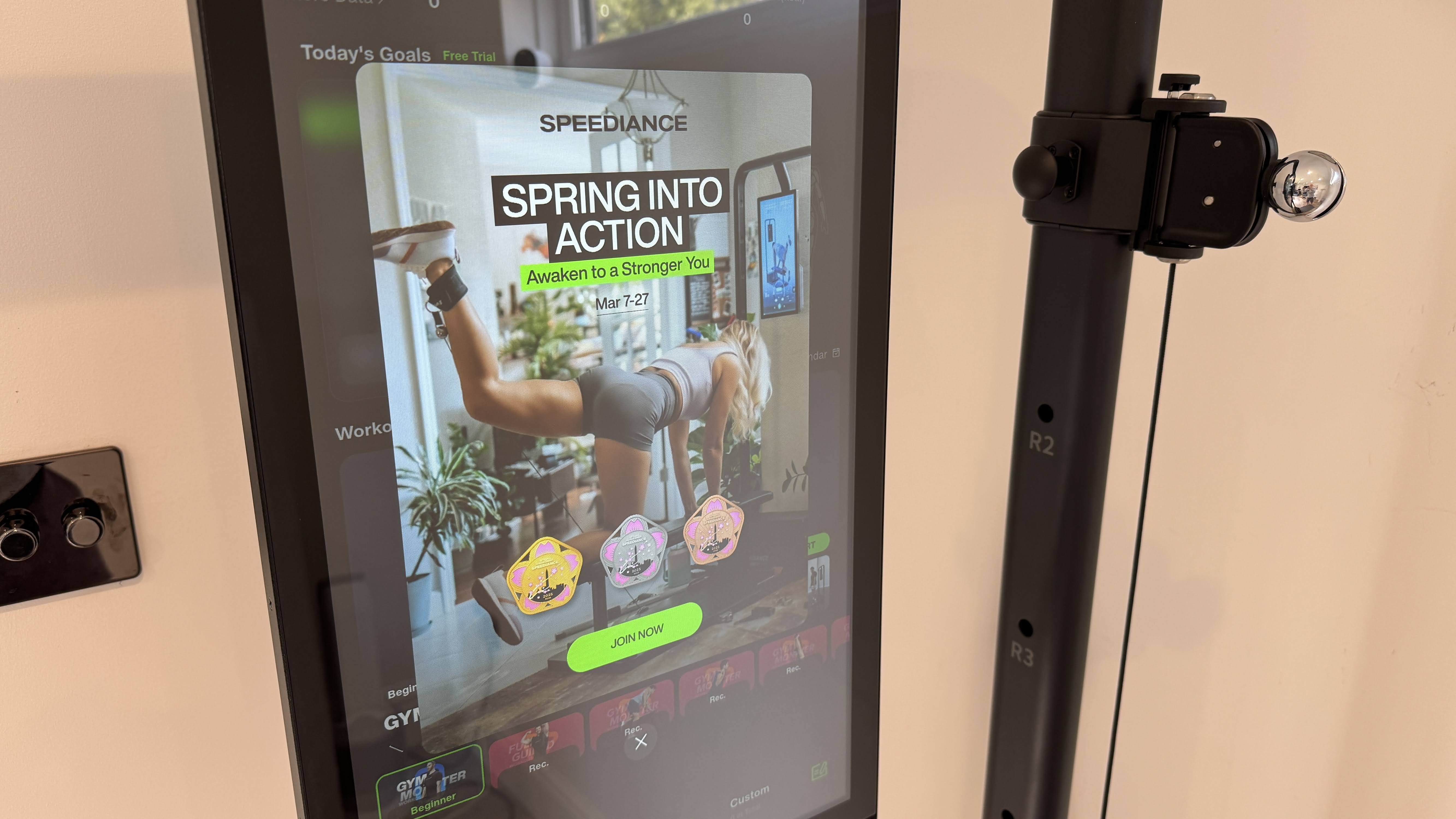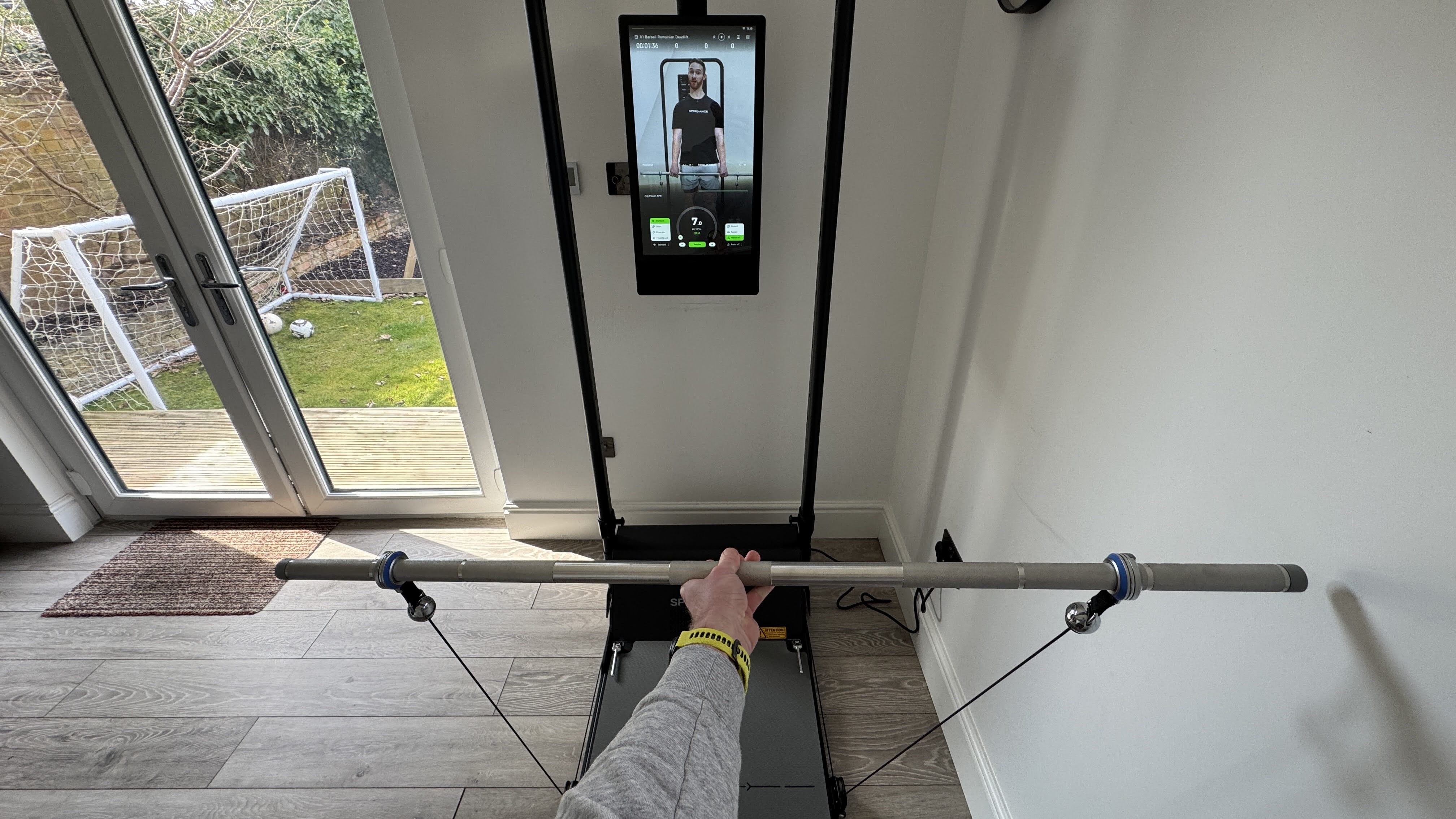If you don’t enjoy going to the gym, then you might be looking at an at-home alternative to help you build muscle and keep up the good work in the comfort of your own home. That was my thinking when I agreed to long-term test the Speediance Gym Monster 2, an AI-powered home gym machine, and it’s absolutely gorgeous – if not quite perfect.
Before we go any further, in order to fit the Gym Monster 2 into your home, you’ll need a little space to fit the machine in, but much less than most conventional home gyms; this takes up a seriously small amount of room when lined up in its closed position against the wall. Once folded down it does need a bit more room but not a massive amount; think the surface area a rowing machine or one of the best treadmills would take up.
Specifically it’s 48.03 x 27.16 x 72.83 inches (unfolded), 14.56 x 27.16 x 72.83 inches (folded). Also, if you’re doing mat work, like stretching or yoga and pilates classes, it will mean you need a bit more space.
Got enough room? Ok, moving on.
The idea here is to get you to build muscle without the risk of dropping free weights at home, while still offering the heavy resistance and freedom of movement required, along with the guidance of the best fitness apps built into the setup. The machine uses a pulley system and clips that are quick to change, so you can swap attachments and perform a huge variety of movement combinations. Throw in that massive 21.5-inch 1080p touchscreen display, backed by a hefty 2.1-channel bass-backed speaker, and you have a full-on training experience.
Fully equipped

Before the Gym Monster 2 arrived, I was using the gym twice a week. On one day, I did the big five movements comprising of squats, deadlifts, a push, a press and a carry. Then on a second day, I usually worked on specifics like shoulders, rotator cuffs, hips, arms and the like, varying as I fancied.
I was surprised to discover I could actually get four of my big five movements done on the Gym Monster 2, without having to scrimp on weight either. The carry wasn’t an option here but I was surprised how effective the squat, deadlift, push and pull options were. In fact, thanks to the wire-based safety, I was able to feel more confident and push myself where I might not have done using free weights.
There are a few variations to this setup, with the basics covering most workouts. The cable is adjustable, allowing you to perform vertical exercises such as pull-downs and bicep curls, or horizontal exercises such as rows, cable flys and face pulls. However, there are tiered options with more attachments, such as an adjustable bench for even more workout variation or a rowing machine .
However, the basic setup is generous with a flat bench, barbell, barbell hooks, barbell cushion, ankle straps, tricep rope, handles, extender belts and even a Bluetooth ring for tracking your heart rate. A great touch, although it’s hardly as feature-packed as the best smart rings.
Prices start at an already-sky-high $3,649/ £2,999/ AU$4,499 for the basic setup, then go to $3,799/ £3,198/ $4,799 for the Gym Monster 2 Works Plus, with that adjustable bench, and move to the top end with the Gym Monster 2 Family Plus, with a rowing bench and rowing bar at an eye-watering $4,199 / £3,689 / AU$5,399.
What I loved

Heavy weights at home have, traditionally, meant using a lot of space and hard work when preparing your home gym. The Gym Monster 2 setup is simpler and a real space-saver. I was impressed that this can go right up to 100kg which, for me at least, is enough for a good deadlift workout, although it may not be enough for serial strength athletes and deadlift enthusiasts. The fact it’s on the wire meant it felt more supported and safer to lift than a free bar, which is great for building confidence with those heavy lifts.
The assist feature helps enormously here too. There are two settings and these intelligently kick in to support you, should you start to struggle; this mode is like having a spotter with you. It will detect you’re slowing at the top end of the movement, and will lighten the weight so you can get that rep finished. This is both great for safety but also for confidence, so you do find yourself pushing beyond your limits to progress.
I really liked the variations of weight styles too. Use Eccentric Mode, for example, and this will add resistance both on the outward and inward movements, allowing you to do double the work in half the time. This also means you’re working more muscles for an overall better balanced finish and, theoretically, faster gains too. Chain mode is similar, only this makes it harder to lift the further through the rep movement you get, as if chains are hanging off you and curling onto the floor during the movement, changing the resistance.
While many other home gym machines are great for cardio, I’ve never used one that’s so great for weight training and actually has some features that make it better than what’s available in the gym. The lessons are as helpful as the movements are clear, while the machine uses AI to tailor the selection to your goals. You don’t feel rushed as you’re in control with the ability to “add 15 seconds” on your timer between sets as needed. There are some really helpful guidance comments that help you to think about how your body should be setup to lift safely and get the most out of each movement. It feels like you have a trainer with you.
I have to admit I was expecting to feel a little anxious using heavy weights on something that folds up so small against the wall. Yet when clamped out and down this is solid with no wobble at all. I felt totally comfortable even when lifting the maximum end at 100kg; the machine does not move.
The classes, it’s worth noting, are included and don’t require a subscription. That said, Speediance is apparently going to start charging a subscription fee for the Wellness+ AI guidance feature from June 1, 2025.
What I didn’t love

While there are very few genuine gripes about this machine, at the price it’s selling for you can’t help but notice even the slightest inconvenience.
Right up front there was an issue connecting to WiFi. The resolution? I had to lower my security settings, which did leave me feeling less than safe but, ultimately, was the only way to get this up and running. It won’t work at all without an internet connection.
Once that was sorted, the simple installation process was over and I’d done a few classes, I found myself using the free weights mode to work as I needed. Once you’ve set the weight and style of lift, you need to hit the button to turn on the weight which pulls the cables tight, immediately. This can be a problem during movements like the bench press; to start the exercise, you need to press the button (behind you on the screen) and then get in and under the weight with the heavy setting on. It was too tricky to reach when in position sometimes. Speediance could do with either adding an option to delay the weight being added after you press the button, so you have time to setup, or use voice controls. This could also be a helpful safety feature if you want to turn the weight off mid-lift.
While the maximum weight is great, at 100kg, it does feel a little less than a free weight of the same value. This is a bit more like doing it on the smith machine, so you have that support and safety, but perhaps it’s ever-so-slightly less taxing than the free weight version might be. This is of course a good thing as well as bad, depending on your training goals and whether you prioritize safety over strength.
Another gripe, albeit relatively minor, is that some of the workouts have you moving from bar to dumbbell to bar, meaning you have to keep changing the setup each time. Perhaps grouping in an order that minimizes the change of kit would be a better way to make the experience feel more seamless. That said, if varying the weights helps your overall training, then that does take precedence over convenience. But surely there’s a middle ground?
Finally, the power off isn’t ideal. You can digitally turn the machine off, but it will make whirring sounds every now and again for a period of time, which can be distracting if you’re in the room. So instead I turned it off at the mains each time, which means a longer start-up.
Verdict

The Gym Monster 2 is a compact-yet-expansive workout setup for the home which delivers convenience while helping you to safely push your limits.
The ability to workout specific muscles, with feedback on fatigue, is a really helpful feature. The option to search workouts that target certain areas, or only get workouts suggested based on the kit you select, also helps to focus training on outcomes.
You could make a saving by going for the original Gym Monster, if you don’t mind that this newer model offers a smaller footprint, enhanced speaker system and a better motor cooling setup for quieter running. However, this is a superb way to safely push your strength gains forward, and it’ll certainly keep you coming back for more.





























































